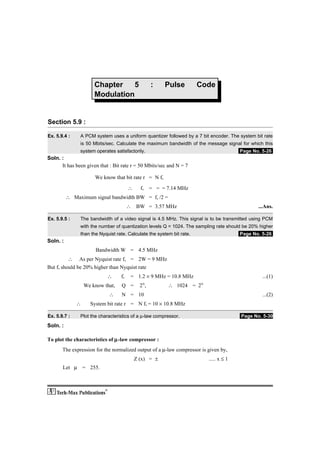This document contains solutions to examples related to pulse code modulation (PCM). It begins by solving examples calculating the maximum bandwidth, sampling rate, number of bits, and bit rate for various PCM systems processing different types of signals. It then solves additional examples involving quantization noise power, signal-to-noise ratios, step sizes, and transmission bandwidths for PCM systems. The document provides detailed calculations and reasoning for each example solved.



![Digital Communication (GTU) 5-4 Pulse Code Modulation
∴ δmin = = = 0.3436 Volt...Ans.
2. Granular noise power :
Nq = × = × = 2.15 × 10– 3 W ...Ans.
3. Signal power So and SNRo :
As the signal is sinusoidal, the normalized output signal power
So = [A/]2 = A/2 = 1/2 Watt. ...Ans.
∴ SNRo = = = 232.3 or 23.66 dB.
4. Signal power for uniformly distributed signal :
The signal PDF for a uniformly distributed signal is as shown in Fig. P. 5.15.9.
Fig. P. 5.15.9
∴ Mean square value of the signal, E[S2] = S2 ⋅ fs (S) dS = S2 dS = = 1/3
Assuming R = 1.
Normalized signal power So = Mean square value = 1/3 W ...Ans.
Signal to noise ratio = SNR = = 155.03 or 21.9 dB ...Ans.
Ex. 5.15.10 : The information in an analog signal voltage waveform is to be transmitted over a PCM
system with an accuracy of ± 0.1 % full scale accuracy. The analog voltage waveform has
a bandwidth of 100 Hz and an amplitude range of – 10 to + 10 Volts.
(a) Determine the minimum sampling rate required.
(b) Determine the number of bits in each PCM word.
(c) Determine the minimum bit rate required in the PCM system.
(d) Determine the minimum absolute channel bandwidth required for the transmission
of the PCM signal. .Page No. 5-61
Soln. :
It has been given that,
1. Accuracy of ± 0.1 % of full scale is expected.
2. W = 100 Hz and amplitude range is – 10 to + 10 V
(a) Sampling rate fs :
By sampling theorem the minimum sampling rate is
fs (min) = 2W = 200 Hz ...Ans.
(b) Number of bits per word (N) :
As accuracy is expected to be ± 0.1 % of full scale, the maximum quantization error should be
± 0.1 % of full scale.](https://image.slidesharecdn.com/chap-5-120722024550-phpapp02/85/Chap-5-4-320.jpg)
![Digital Communication (GTU) 5-5 Pulse Code Modulation
∴ ∈max = ± 0.1 % of full scale
= ± 0.001 [10 – (– 10)] = ± 0.001 × 20
∴ ∈max = ± 0.02 Volts ...(1)
We know that the maximum value of the quantization error is
∈max = ± S/2 ...(2)
∴ ± S/2 = ± 0.02
∴ S = 0.04 Volt ...(3)
But S =
where VH = 10 V
and VL = – 10 V
∴ Q =
= = 500 ...(4)
But Q = 2N
∴ N log10 2 = log10 500
∴ N = 8.96 ≈ 9 ...Ans.
(c) System bit rate :
System bit rate (r) = N fs = 9 × 200 = 1800 bits/sec ...Ans.](https://image.slidesharecdn.com/chap-5-120722024550-phpapp02/85/Chap-5-5-320.jpg)






